Want to make sure your images look great when shared on Pinterest?
Pinterest can drive more visitors to your site, but we find that Pinterest’s recommended image sizes doesn’t always good in blog layouts.
Here at WPBeginner, we’ve been helping people create beautiful images for their websites for well over a decade. We know the ins-and-outs of creating images that look great on your website, and across social media – and that includes Pinterest.
In this post, we’re sharing the trick to hiding Pinterest images in your blog posts, so they don’t ruin your website’s layout. It really is the best of both worlds, so let’s get started!

Why Hide Pinterest Images in WordPress Posts?
Pinterest is a popular social networking site that allows you to share visual content and get more visitors to your website.
That’s why so many website owners verify their WordPress website with Pinterest.
By adding a Pinterest-friendly image to your blogs, you can encourage visitors to pin your content. This can help you stand out in the Pinterest pin feed and search results and increase your blog traffic.
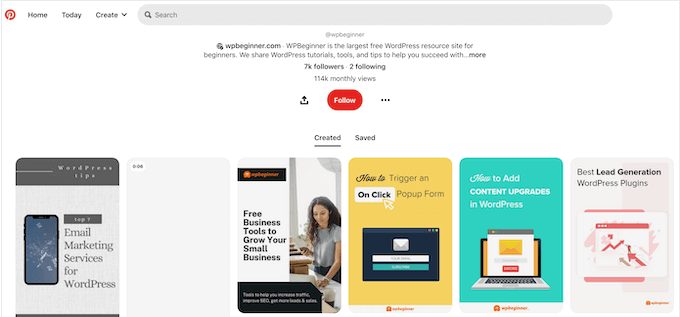
However, the Pinterest image dimensions are long and narrow (3:2), which can look strange in WordPress blog layouts and image galleries.
These large images can also slow down your website, which will affect the user experience and could even hurt your image SEO.
By hiding the Pinterest images, readers can share your content to Pinterest without the images ruining your blog’s layout or slowing down your website.
How to Hide Pinterest Images in WordPress
The best way to hide Pinterest images in your blog posts is by using WP Tasty Pins.
WP Tasty Pins is the best WordPress Pinterest plugin for SEO. It helps optimize your images for Pinterest so you can get more visitors to your website. You can use it to easily add ‘Pin It’ hover buttons over all your images, create fully customizable ‘Pin It’ banners, and more.
First, you’ll need to install and activate the plugin. If you need help, then please see our guide on how to install a WordPress plugin.
Upon activation, just go to Settings » Tasty Pins. You can now add your license key in the field toward the top of the screen.
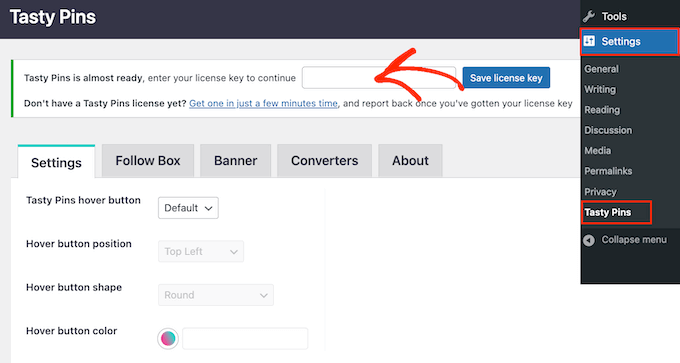
You will find this information in your account on the Tasty Pins website and in the confirmation email you received when you purchased Tasty Pins.
With that done, click on the ‘Save license key’ button.
Now, you can add the image in WordPress. Simply open any page or post in the WordPress content editor, and then find the Tasty Pins section.
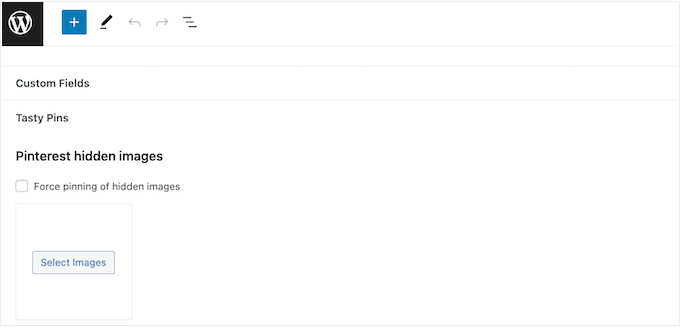
To start, click on ‘Select Images’ and then choose the image you want to use.
Pro Tip: This plugin may hide the Pinterest image, but lots of large, high-resolution images can still affect your site’s loading speeds. With that in mind, it’s still important you optimize your images before uploading them to WordPress.
You then have the option to force pin this image. This means that no matter what image the visitor clicks on, this exact graphic will be pinned to Pinterest. In this way, you can make sure that the pinned image is designed specifically for Pinterest and looks great on this popular social site.
To force pin this image, check the box next to ‘Force pinning of hidden images.’
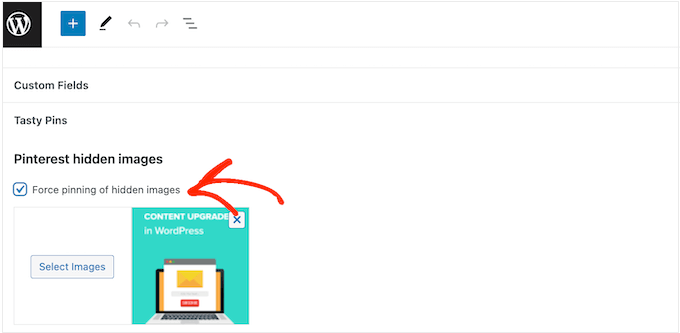
Next, you can type in a default Pinterest title and description. Similar to WordPress alt text and image titles, this can help optimize your site for the search engines.
However, keep in mind that Pinterest users will see the title and description when they are scrolling through their feed, so you’ll also want to make this information eye-catching.
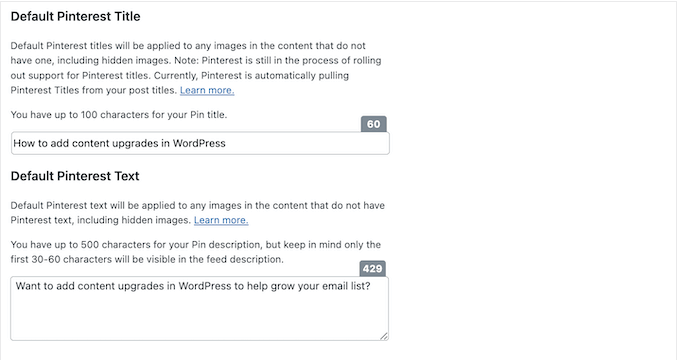
When you are happy with the information you’ve entered, either click on ‘Update’ or ‘Publish’ to make your changes live.
Now, visitors will only see the Pinterest image when they save your site to Pinterest.
FAQs About Hiding Pinterest Images in Your WordPress Blog Posts
In this guide, we showed you how to improve your website’s performance and layout by hiding Pinterest images. If you still have questions, then here are our FAQs about hiding Pinterest images in your WordPress blog posts.
Can I Hide Pinterest Images in WordPress Without Breaking Terms of Service?
You might have heard that hiding Pinterest images on your WordPress blog goes against the Pinterest Terms of Service (TOS). However, this isn’t true.
You are allowed to hide Pinterest images on your website as long as you meet the following criteria:
- The Pinterest image matches your post’s content.
- The Pin description matches your post’s title or content.
Essentially, you can hide images on your WordPress website as long as the image you are hiding is relevant to your page.
Do Hidden Pinterest Images Impact My Google Ranking?
Google has to index your content before it can properly rank your site. This means the search engines need to be able to crawl your site and see all your pages and media.
For this reason, Google isn’t necessarily a big fan of hidden images or hidden content. In fact, hidden content is often associated with spam websites and black hat SEO scams.
However, for genuine use cases like this one, you should be able to hide Pinterest images without it negatively impacting your Google ranking.
We hope this article helped you learn how to hide Pinterest images on your WordPress blog posts. You may also want to see our expert pick of the best slider plugins, or see our guide on how to do basic image editing in WordPress.
If you liked this article, then please subscribe to our YouTube Channel for WordPress video tutorials. You can also find us on Twitter and Facebook.





Syed Balkhi says
Hey WPBeginner readers,
Did you know you can win exciting prizes by commenting on WPBeginner?
Every month, our top blog commenters will win HUGE rewards, including premium WordPress plugin licenses and cash prizes.
You can get more details about the contest from here.
Start sharing your thoughts below to stand a chance to win!
Ismail says
Hello, I’m wondering if there’s any other free alternative to this plugin as Shared Counts – Pinterest Image needs to work with Shared Counts plugin. Thanks.
WPBeginner Support says
We will take a look into other alternatives but for plugin compatibility questions we would recommend reaching out to the support for the plugin you are using and they should have a recommendation
Admin
Micki says
Thank you for your help.
WPBeginner Support says
You’re welcome!
Admin
Micki says
In the WordPress plug-in library, the Shared Counts-Pinterest image plug in is showing as not having been updated for two years and not tested with my version of WordPress. Is it safe to install a plug in that hasn’t been updated in 2 years? I really want to install it but don’t want to break anything on my site.
Thank you so much for all of the information you provide.
WPBeginner Support says
The plugin should still be working, for the warnings you are receiving we would recommend taking a look at our recommendations below!
https://www.wpbeginner.com/opinion/should-you-install-plugins-not-tested-with-your-wordpress-version
Admin